
作者:中国科学技术发展战略研究院
页数:119
出版社:科学技术文献出版社
出版日期:2020
ISBN:9787518939428
电子书格式:pdf/epub/txt
内容简介
Improving indigenous innovation capability and building an innovation-oriented country
are the strategic goals set forth in China’s Outline of the National Program for Longand
Medium-Term Scientific and Technological Development (2006—2020). The Chinese
Academy of Science and Technology for Development began working on the national
innovation index (NII) research in 2006 in order to track and assess China’s progress in
building itself into an innovation-oriented country. With the support and assistance from the
Ministry of Science and Technology and its related departments and bureaus, related public
institutions, and experts from various sectors, the National Innovation Index Report has been
published annually since 2011. The National Innovation Index Report 2019 is the 9th release.
The National Innovation Index Report, as one of the reports of the “national innovation
survey system” series prepared in accordance with the Measures for Implementation of the
National Innovation Survey System, is a state-level innovation capacity evaluation report.
Drawing upon domestic and international theories and methods of evaluation of national
competitiveness and innovation capacity, it is based on an indicator matrix comprising five
pillars, i.e. innovation resources, knowledge creation, enterprise innovation, innovation
performance, and innovation environment. This report is still framed around the same
indicator system structure as the previous release, which consists of 5 first-level indicators
and 30 second-level indicators. The 30 second-level indicators include 20 quantitative
indicators which highlight innovation scale, quality and efficiency and international
competitiveness while maintaining a balance between large and small countries, and ten
qualitative indicators which reflect the innovation environment.
This report continues to feature 40 countries with active science, technology and
innovation (STI) activities (whose combined R&D expenditure accounts for more than 95%
of the world’s total), and continues to use the commonly adopted benchmarking method
worldwide to calculate the national innovation index. All data are obtained from databases
and publications of governments or international organizations, and are internationally
comparable and authoritative. It calculates the innovation index scores of the 40 countries
based on the latest statistical data (2017 data unless otherwise indicated) and compares them
with their performances in the previous release.
In today’s world, a country’s prosperity and sustainable development is mainly
dependent on the development and accumulation of its national innovation capacity,
rather than on the size of population or availability of natural resources. In the face of the
opportunities and challenges accompanying science and technology development and the
evolution of the international political and economic landscape, countries are increasing
investment in innovation resources to strengthen their innovation capacity. Against the
backdrop of global competition, China moved up to the 15th spot in the national innovation
index with a higher overall index score, further narrowing its gap with advanced countries.
The report to the 19th CPC National Congress expressly put forward the strategic task
of “accelerating the construction of innovative country”. The establishment of the national
innovation survey system will create favorable conditions for improving the innovation
evaluation indicator system and advancing national innovation capability monitoring and
evaluation. The effort to evaluate China’s comprehensive innovation capability, track its
innovation capability development and analyze the gap with leading innovation-driven
countries requires continuous exploration and in-depth research. We sincerely hope that the
annual National Innovation Index Report will provide the public with a window through
目录
Part I China’s Innovation Performance Through Data 1
I. China’s Progress in Key Innovation Indicators 2
(I) Input of Innovation Resources Steadily Grows 3
(II) Knowledge Creation Capacity Continues to Increase 8
(III) Innovation Makes Increasing Contribution to Economic Growth 11
II. China’s Position in the Global Innovation Landscape 14
(I) The Global Innovation Landscape Is Shifting to Being Dominated
by the Trio of North America, Europe and Asia 15
(II) China Outperforms Other Upper-Middle-Income Countries 18
(III) China’s Development Potential Lies in Innovation Quality
Improvement and International Cooperation 22
III. Assessment on National Innovation Index Indicators 29
(I) Input of Innovation Resources Makes Notable Progress 31
(II) Knowledge Creation Continues to Take the Lead 33
(III) Enterprise Innovation Abilities Remain Stable 36
(IV) Innovation Performance Improves Significantly 40
(V) Innovation Environment Needs Further Improvement 43
IV. China’s Innovation Capacity Development and Evolution 46
(I) China’s Movement in the National Innovation Index 47
(II) Progress and Outlook for Indicator Targets of China’s 13th
Five-Year National Plan for Science, Technology and Innovation 52
Part II Country Analysis 57
Part III Assessment Methodology 99
I. Assessment Approach 100
(I) Objective of Assessment 100
(II) Meaning of an Innovation-Driven Country 100
(III) Theoretical Basis 102
(IV) Criteria of Indicator Selection 102
II. Indicator Matrix 104
III. Calculation Methodology 106
(I) Treatment of the Second-Level Indicator Data 106
(II) Calculation of the First-Level Indicator Score 106
(III) Calculation of the National Innovation Index Score 107
(IV) Calculation of China’s National Innovation Index Score
Increases 107
Appendixes 109
Appendix I Index and Sub-index Scores and Rankings 110
Appendix II Definitions of Indicators 113
Appendix III Data Sources 118
ii
National Innovation Index Report 2019

![国家创新指数报告(2013年 英文版) [NATIONAL INNOVATION IND]-技术教育社区](https://image12.bookschina.com/2018/20180721/1/B7285448.jpg)













